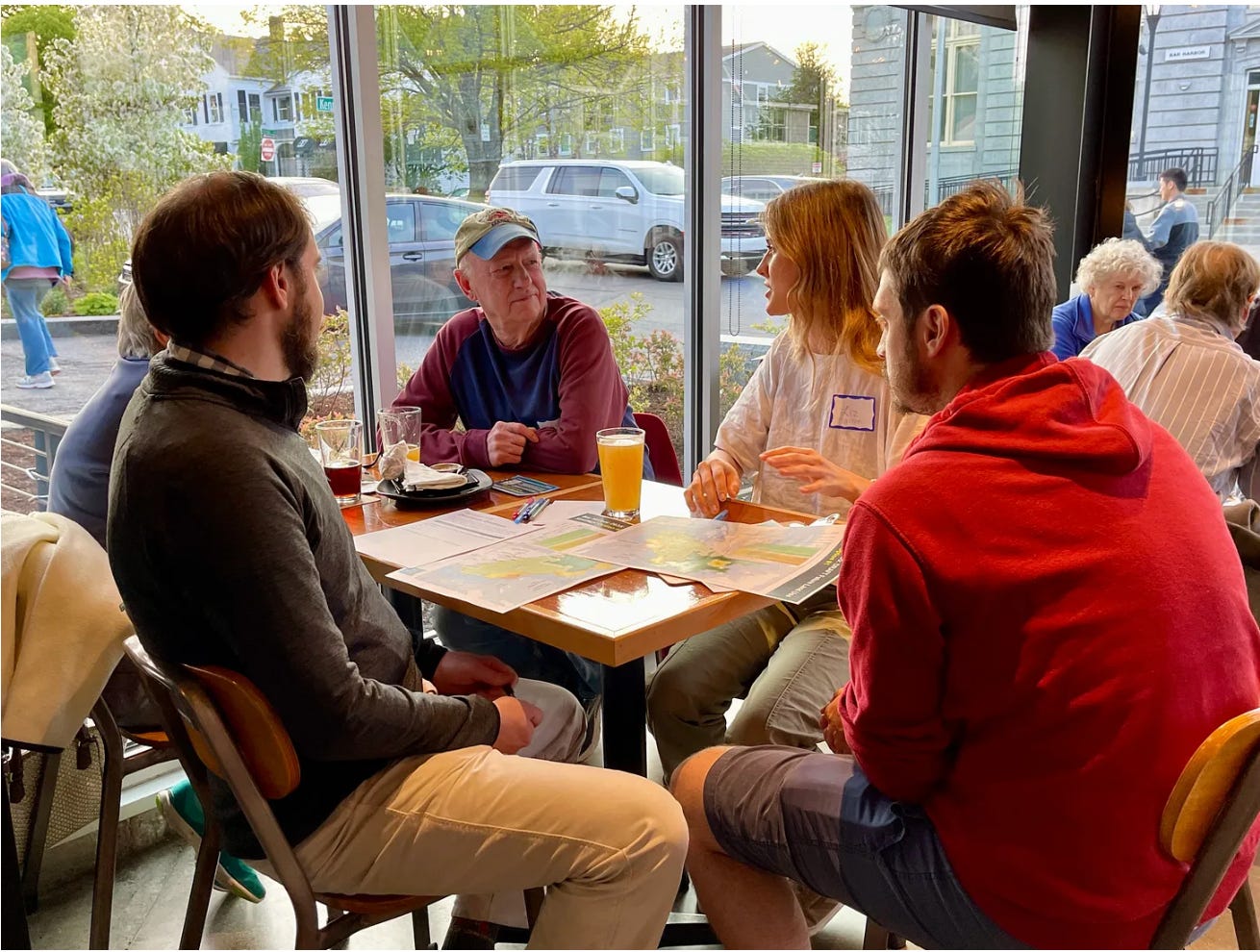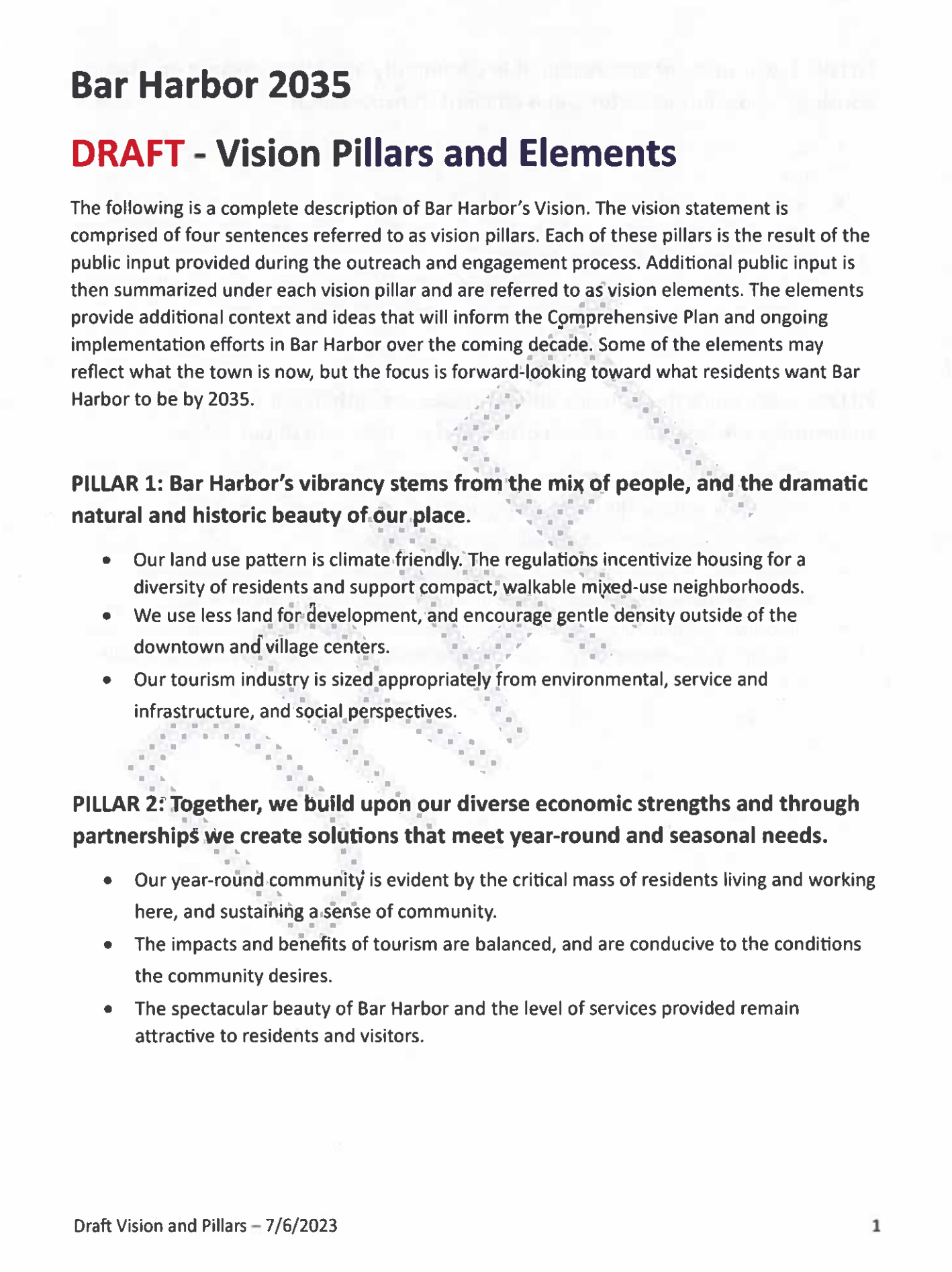Where Are the Kids?
Comprehensive Plan Committee Members Dig In Deeply Into Town's Vision with What Might Be Missing and What Could Be Tweaked
BAR HARBOR—The Comprehensive Planning Committee met June 12 to discuss the feedback from the May visioning workshops, elect new officers, and also to discuss draft elements of the plan itself.
“The success ladder is broken in town,” Comprehensive Planning Committee member Elissa Chesler recalled hearing a younger resident say at a past meeting.
The question becomes how does the town’s state-mandated comprehensive plan for 2035 help fix that. Does it want to?
Schools, a diverse economy, job opportunities all go hand in hand, but schools and education, new Vice Chair John Kelly noted, aren’t even included in the current draft language of the vision statement.
The goal, then, is how to put all of that in both the comprehensive plan’s broader vision statement and its details. It’s a question that the committee members and consultants began to address Wednesday night.
WHAT IS THE COMPREHENSIVE PLAN?
According to the town’s website,
“The purpose of the new Bar Harbor Comprehensive Plan is to reflect and respond to the needs, values, and priorities of the community while safeguarding Bar Harbor’s sense of place, history, and natural resources. The new plan will serve as a guide for future growth and development, covering subjects such as, but not limited to, land use, zoning, capacity and expansion of utilities, economic development, transportation, housing, recreation, capital budgeting, provision for municipal services and facilities, and regional coordination. The plan will also serve as a foundation for determining effective public policy, master planning, and land use decisions for the future. The new Bar Harbor Comprehensive Plan will have a 2035 outlook. Bar Harbor’s current Comprehensive Plan dates back to 2007. As part of the planning process, the town desires to place a major emphasis on community engagement to involve residents and stakeholders in framing a plan that truly belongs to the community and implements its values.”
There is no set end date yet for the plan or the committee’s end, Steve Whitman of Resilience Planning and Design said. He said the process may go into early 2024 rather than ending in December. The town’s contract with the consulting firm has been extended once previously.
THE PLAN AND LAND USE: HOW IT WORKS
The town is a patchwork quilt of private and public land. The town creates the zoning and regulations for that land.
There may be different opportunities for changes in the future in the use of that land, which is part of what the committee looks at. The comprehensive plan is the blueprint for the changes and future of the town’s land use. But for uses to actually change, the town has to change rules through a series of practical steps that usually come before the Planning Board or Town Council.
New Chair Greg Cox said that those changes often take a huge amount of time. The town and the plan can encourage those changes, but “you can’t force people to do something.”
Chesler said it comes down to incentives and challenges. Those practical steps are a different stage than the higher level of thinking for the comprehensive plan.
Cox said the plan lays out the longer term goals and the Planning Board and Town Council can see if proposals that come before them adhere to the plan’s vision.
The committee members with town staff and consultants create the plan. What is included and what isn’t makes a difference in the town’s future if the plan has teeth. Immediate past Chair Kyle Shank said he’d like the plan to have teeth.
ELECTIONS
Because Shank was elected to the Bar Harbor Town Council this June, town rules stipulate that he could no longer be chair. He can remain on the committee. Vice Chair Greg Cox was the sole nomination for chair and was elected without dissent. John Kelly, current chair of the Parks and Recreation Committee was the sole nomination for vice chair and was elected without dissent. Neither man voted for themselves.
The committee went through a similar process when past Vice Chair Misha Mytar was appointed to the school committee. At that time, Cox was elected vice chair and Mytar stayed on the committee.
MAY VISIONING WORKSHOP SERIES
Liz Kelly, also of Resilience Planning and Design, gave an overview of the four visioning workshops that had been held in May. The workshops solicited feedback on the vision statement and on two possible land use strategy options.
“They were really engaged,” Whitman said of the four sessions. “We were really pleased how well people were willing to play together in the sandbox.” He said the attendees were positive and forward thinking.
Member David Woodside said that the perceived dichotomy between development interests and anti-development interests wasn’t apparent in the workshop session that he attended. Woodside did add that some of the loudest voices in the community did not attend the sessions. Cox agreed that everyone was cordial and all attendees seemed to be listening. Mytar agreed with Woodside.
VISION STATEMENT
Liz Kelly said that her company distilled that most of the workshop attendees were somewhat supportive of the vision statement overall, but wanted more details and specificity toward Bar Harbor.
The consultants then broke apart the vision statement and presented it with draft pillars at the July 12 meeting. The pillars were sentences with bullet points beneath.
Committee members then focused on phrases (climate friendly vs climate resilient) and singular words and if they should be taken out, as well as general ideas, such as including historic building protection in the vision statement. There was also discussion about the only singled-out economic driver called out being “tourism.”
John Kelly said it was unacceptable to say (as one draft pillar did) that the town was balancing the impacts and benefits of tourism. He said that he wanted it to read more toward the impacts of tourism is mitigated.
“We want to minimize or reduce in the context of tourism,” he said.
Mytar agreed. Chesler said that when she first came to Bar Harbor it felt cool that Bar Harbor had tourism and more things than the town normally would if it was just a town of 5,000 people in the woods, but now the negative impacts are felt.
John Kelly emphasized that the visioning statement didn’t mention school or education, or Bar Harbor’s youth and children.
“Where do we spend most of our tax dollars?” John Kelly asked, referencing the school budget.
Cox said that having year-round employees and supporting them, supports the school. “Young families with children can’t afford to live here” which is why, he said, the school numbers have gone down.
LAND USE OPTIONS FEEDBACK
Liz Kelly also discussed the feedback about two land use options originally presented to both the committee and at the workshops.
At the workshops, feedback leaned toward denser development should be focused where infrastructure already exists, with the first option “noted as a starting point, but questions were raised about how to accommodate the needed housing units.”
Liz Kelly went through the report of the visioning workshop series, reading,
“The discussion of Option #2 and the proposed “Potential Additional Residential Areas” near Hadley Point and Salisbury Cove often related to questions and concerns about infrastructure and housing affordability. Many participants wanted more information on the potential to serve these areas with water and sewer infrastructure.
“A similar concern was raised by some related to Town Hill and its current lack of water and sewer infrastructure. Some breakout groups felt strongly that Option #2 is only viable with the expansion of water and sewer infrastructure in those areas due to potential water quality impacts, climate change, and other environmental factors. It was also noted that the shoreline areas of both Hadley Point and Salisbury Cove are not likely to supply affordable housing units.
“The conversations related to Bar Harbor’s future land use strategy highlighted the complexity of putting such a plan into motion through regulatory changes, infrastructure investments, and responsive development partners. All of this takes time, and likely much more than the ten-year time horizon of a comprehensive plan. However, Bar Harbor 2035 could establish a future land use strategy that has a longer-term, implementation horizon that will be accomplished over many comprehensive planning cycles. If this approach is used, it would allow for a more realistic phasing of implementation actions to accomplish this longer-term vision for the community.”
Mytar said she was surprised by how strongly people were reacting to and discussing drinking water during the sessions and suggested that be reflected in the plan. She also said that during the sessions many people were having a hard time understanding the difference in the land use options.
Whitman suggested that maybe option #2 could be seen as a further out goal with option #1 more immediate. Cox wants to prevent sprawl in Hadley Point and Town Hill that would keep those areas from being useful in the future.
THE LAST PLAN
The last plan was in 2007. The plans are meant to guide the town’s priorities and goals for about ten years from its start date.
Planning Director Michele Gagnon and Staff Planner Cali Martinez are taking the goals and strategies of the 2007 Comprehensive Plan and coordinating meeting and discussion with five boards included in the image below.
John Kelly said it seemed like there were several other committees that should be on the list. Martinez said she believed that all the committees were going to be engaged with. Some groups might be met with concurrently. Chesler also asked if the stakeholder organizations discussed in the beginning of the process might be good to check with to see if the 2007 plan goals and strategies are being met or addressed.
LINKS TO LEARN MORE
Different Meetings, Different Perspectives
BAR HARBOR—A bustling Atlantic Avenue Brewery paid host to a comprehensive planning visioning session Tuesday night that attracted at least 50 people. It was the second in a series of four workshops that intended to help the town’s Comprehensive Planning Committee involve the public in the vision statement of the plan and receive feedback about future l…
https://www.barharbormaine.gov/AgendaCenter/ViewFile/Agenda/_07122023-3241
https://www.townhallstreams.com/stream.php?location_id=37&id=49648
https://www.barharbormaine.gov/517/Comprehensive-Planning-Committee












